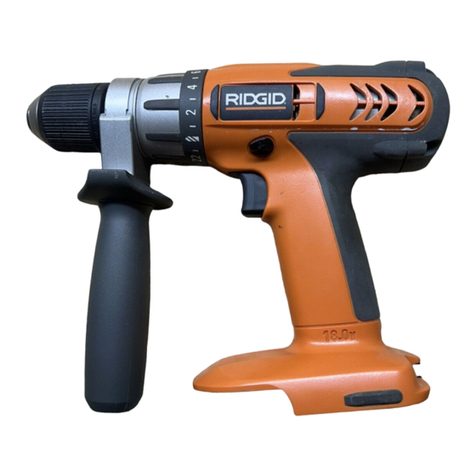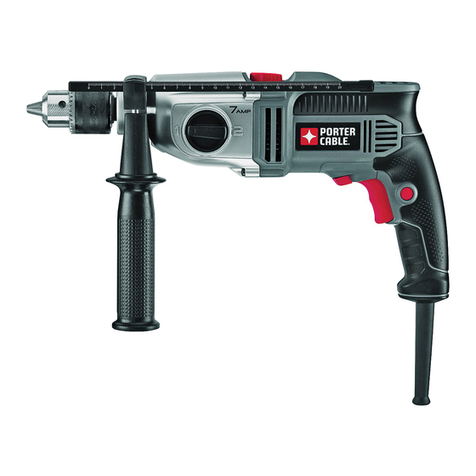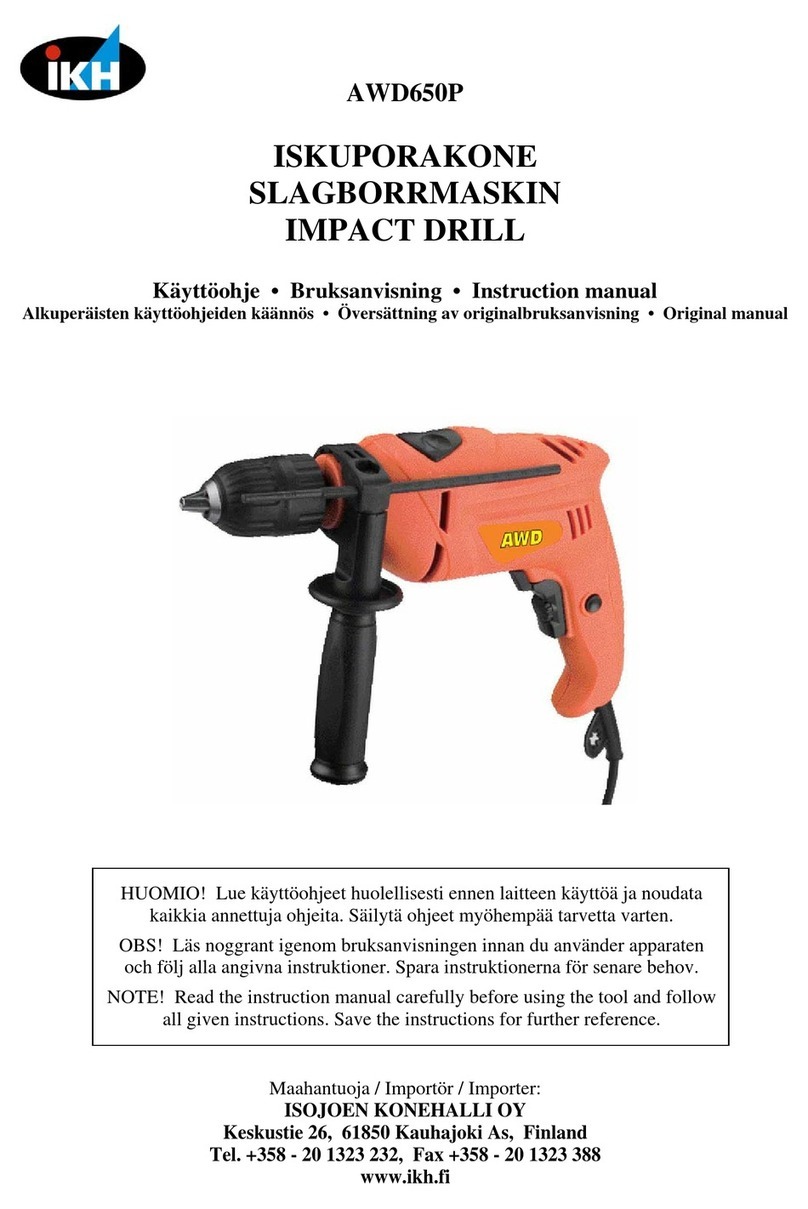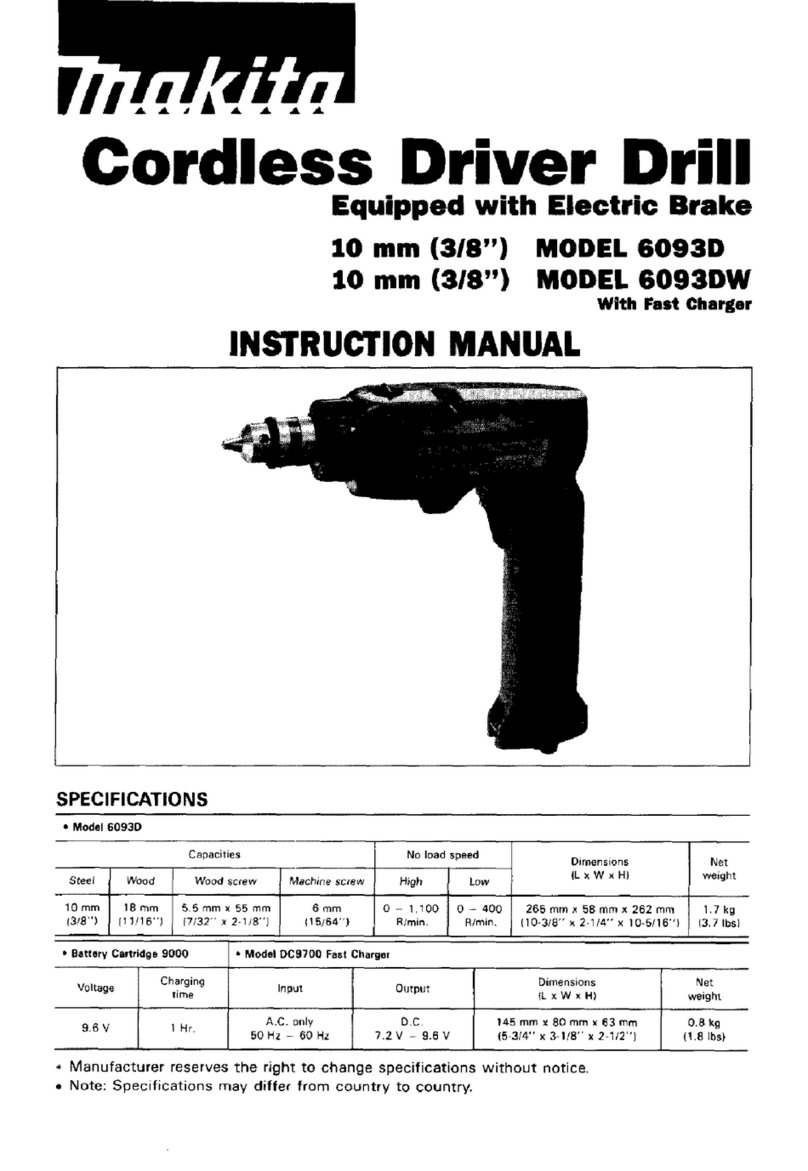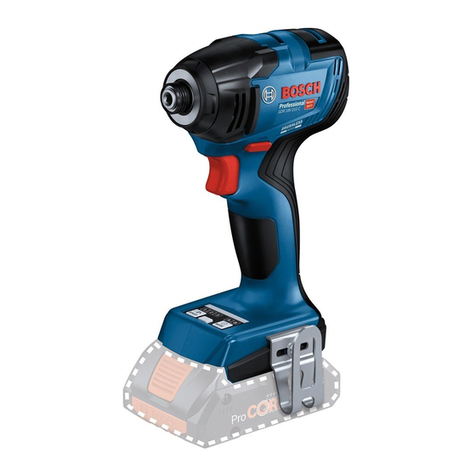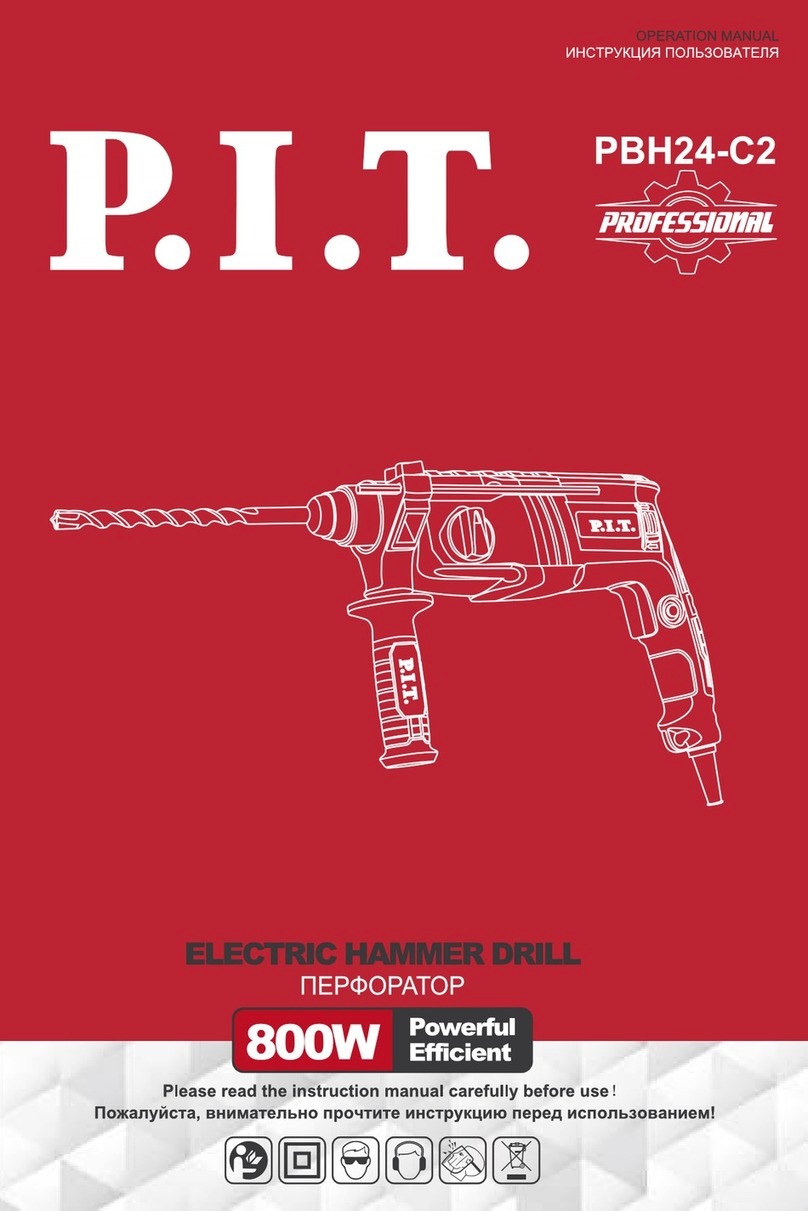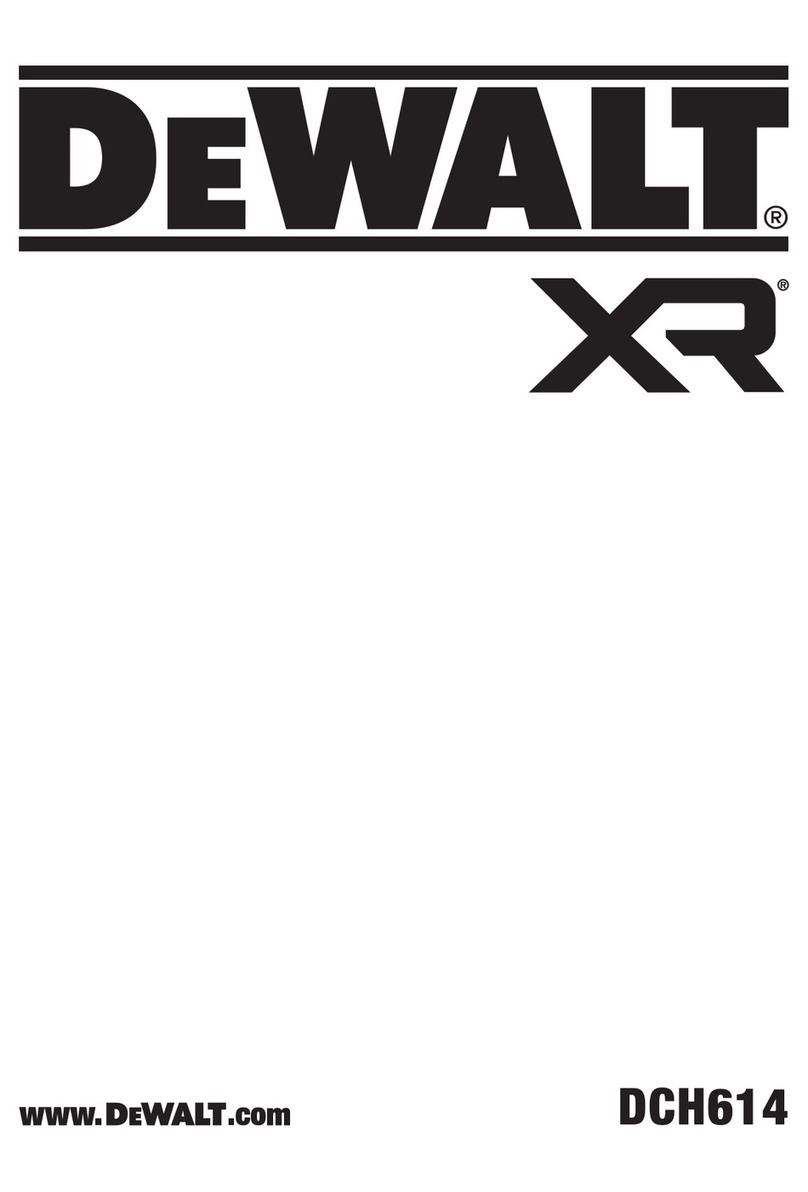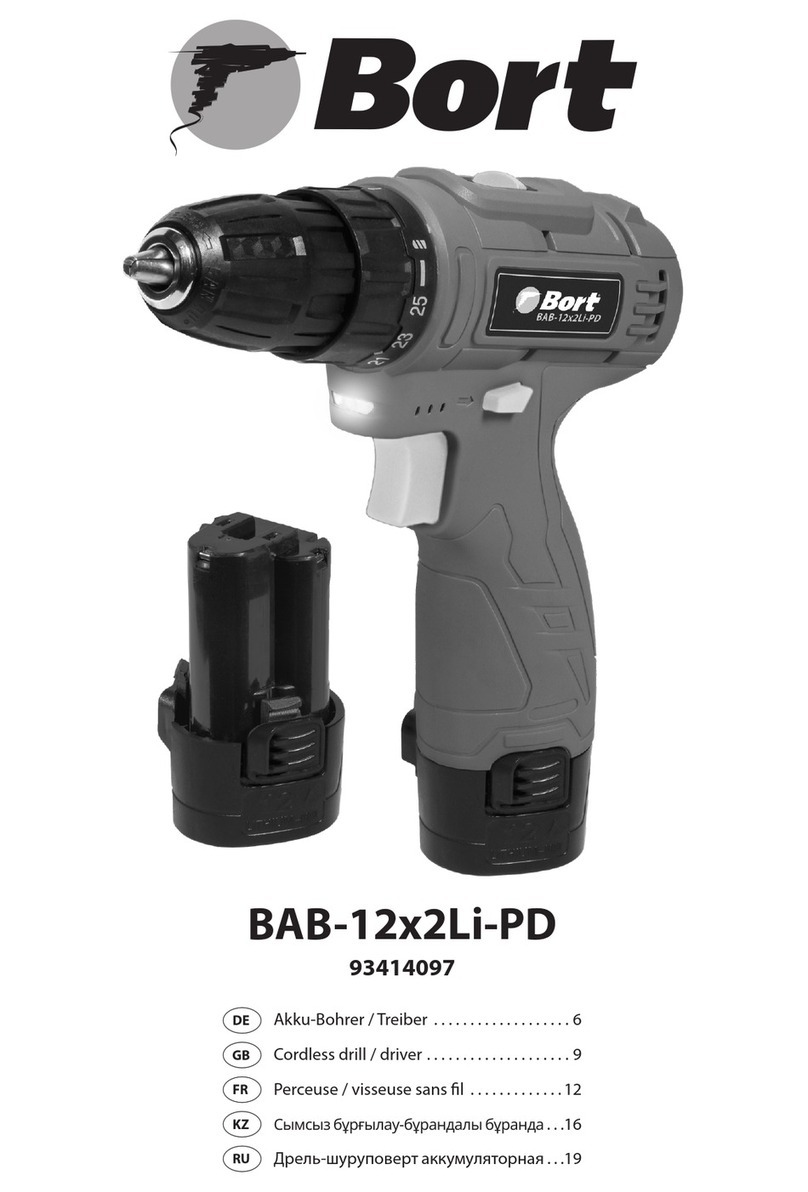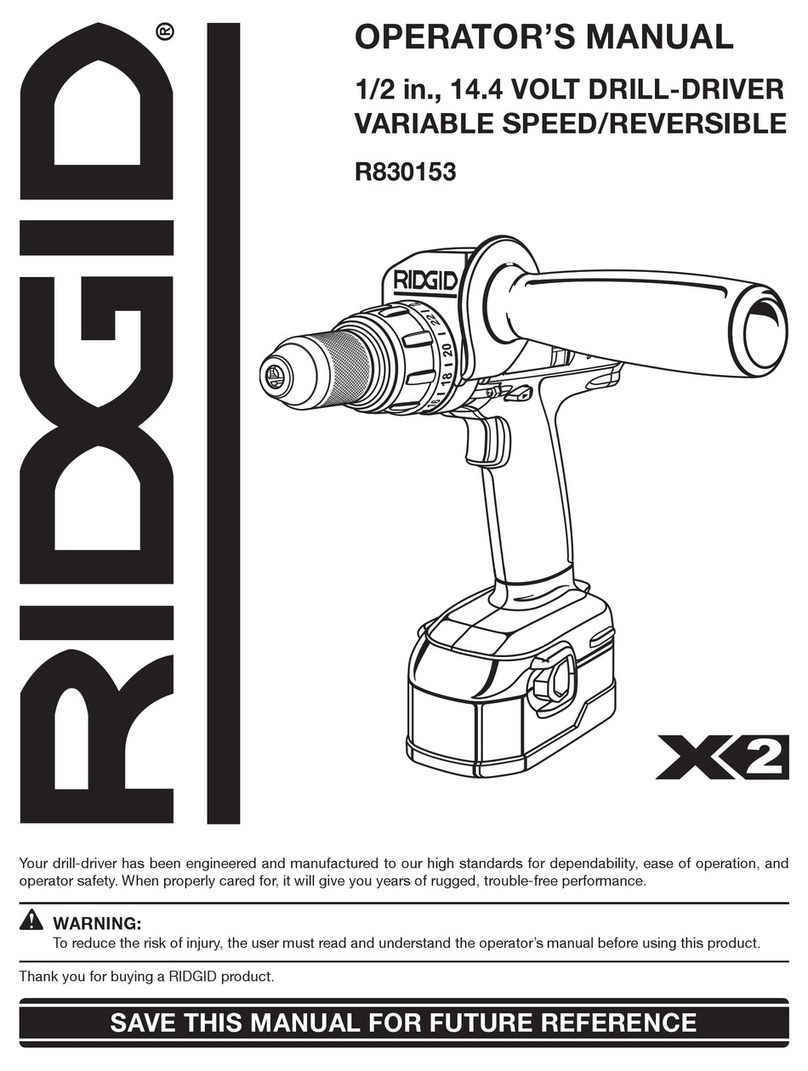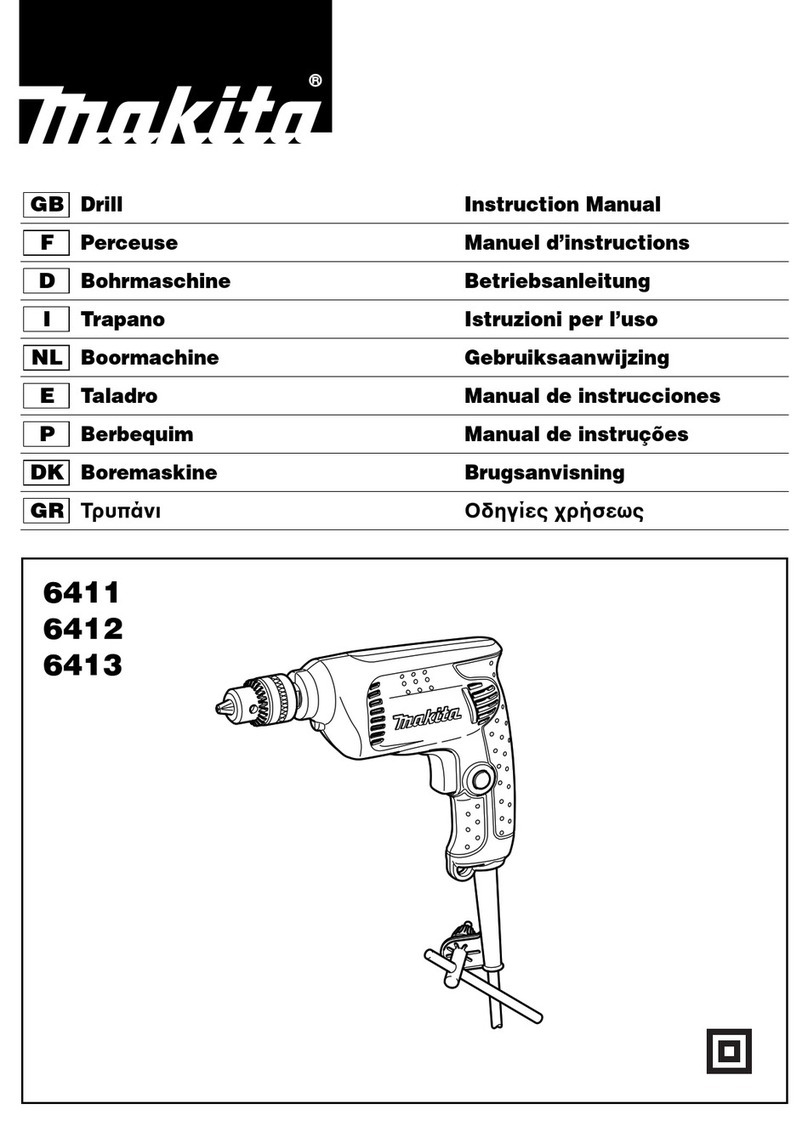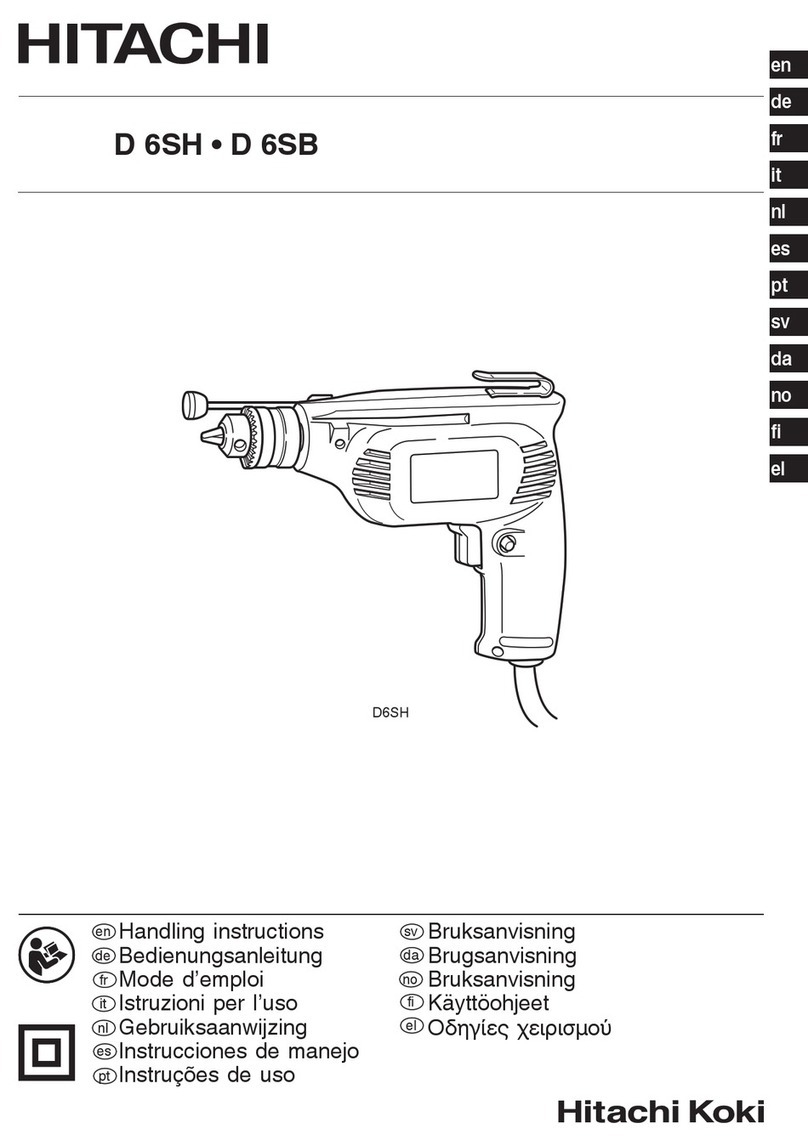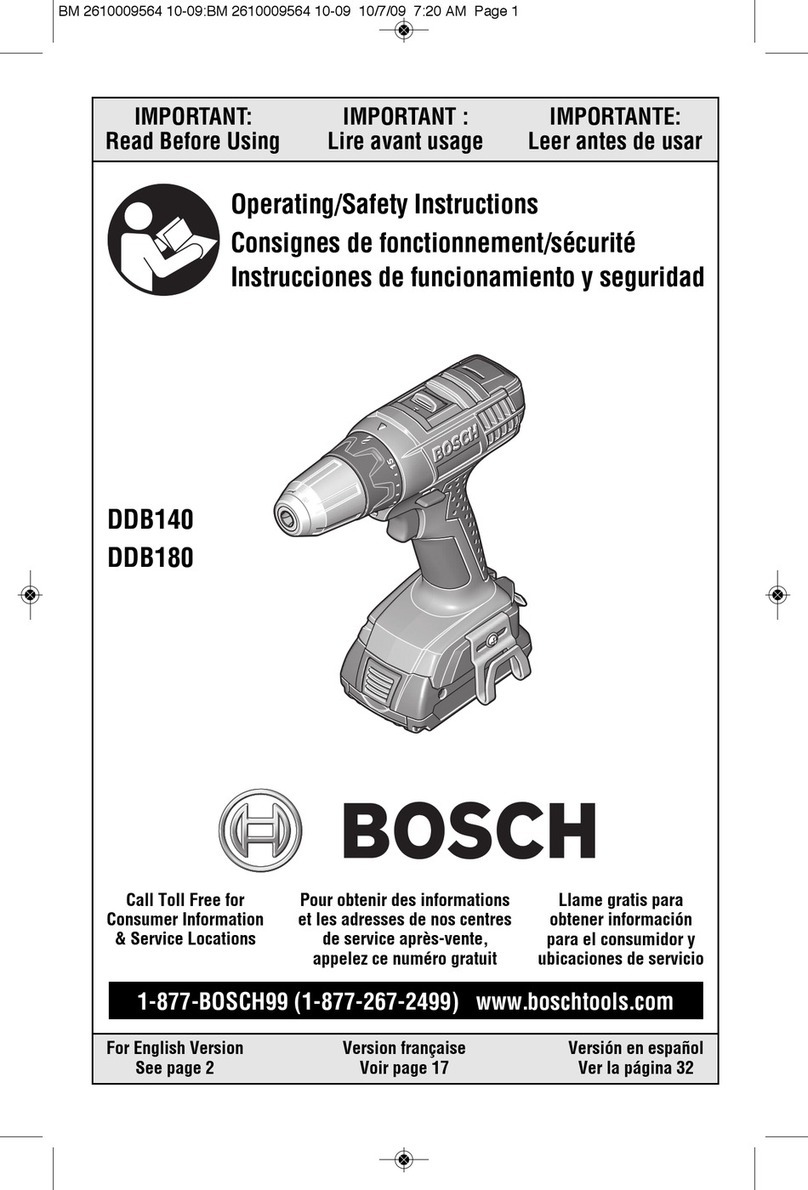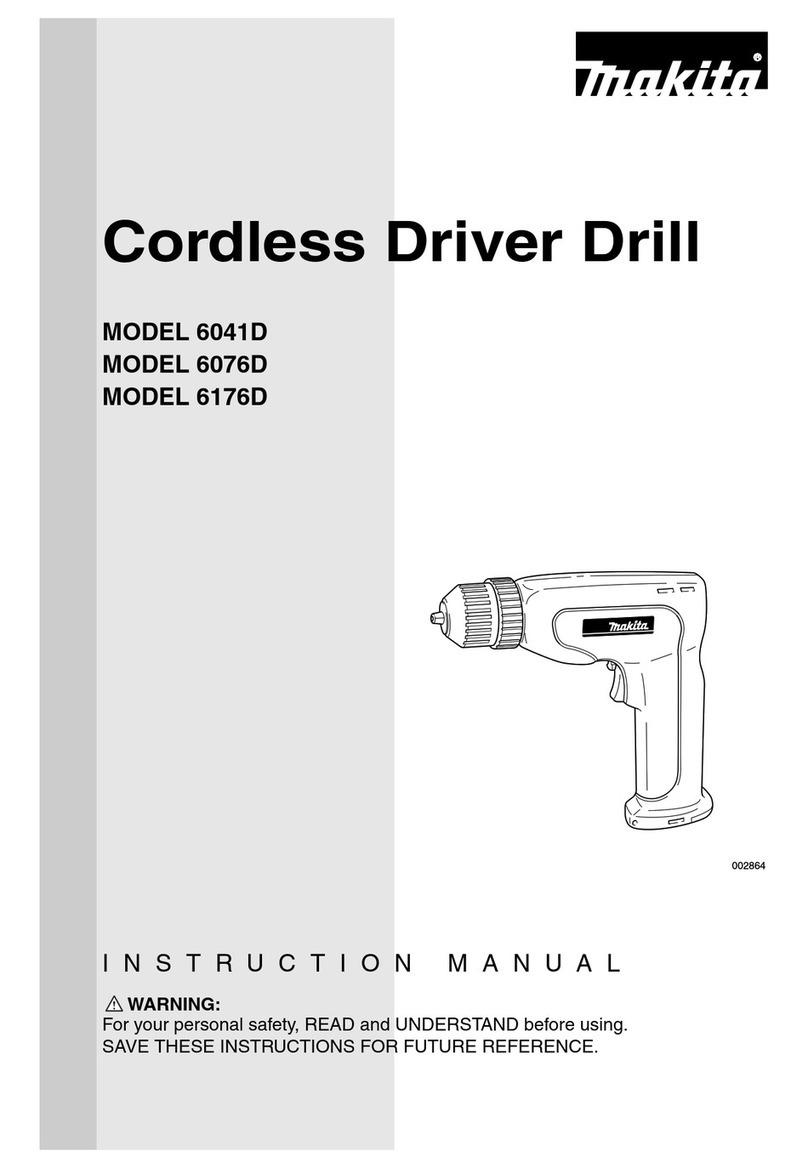B. Braun Aesculap Acculan 4 Manual

Aesculap®Acculan 4
Aesculap Power Systems
Instructions for use/Technical description
Small drill GA344
Gebrauchsanweisung/Technische Beschreibung
Kleine Bohrmaschine GA344
Mode d’emploi/Description technique
Petite perceuse GA344
Instrucciones de manejo/Descripción técnica
Taladro pequeño GA344
Istruzioni per l’uso/Descrizione tecnica
Perforatrice piccola GA344
Instruções de utilização/Descrição técnica
Máquina de furar pequena GA344
Gebruiksaanwijzing/Technische beschrijving
Kleine boormachine GA344
Bruksanvisning/Teknisk beskrivning
Liten borrmaskin GA344
Инструкция по примению/Техническое описание
Малая дрель GA344
Návod k použití/Technický popis
Malá vrtačka GA344
Instrukcja użytkowania/Opis techniczny
Mała wiertarka GA344
Návod na použitie/Technický opis
Malá vŕtačka GA344
Kullanım Kılavuzu/Teknik açiklama
Küçük matkap GA344
사용 설명서 /기술 설명
소형 드릴 GA344

16
13
12
1
14 15
17
11
2
3
5
4
7
89

A
BC
6
7
4
1 1
4
10
18 1
D

2
Aesculap®Acculan 4
Small drill GA344
Aesculap®Acculan 4Small drill GA344
Legend
1Product (small drill)
2Knob (for speed control)
3Safety catch
4Battery bay
5Locking pin
6Sterile funnel
7Battery
8Cover
9Cover release element
10 Battery removal device
11 Knob for left-rotation
12 Arrow
13 Rotating sleeve
14 Adapter (for Kirschner wire protection sleeve and rinsing adapter)
15 Kirschner wire protection sleeve
16 Attachment
17 Rinsing adapter
18 Oil spray adapter
Symbols on product and packages
Caution
Observe important safety information such as warn-
ings and precautions in the instructions for use.
YYYY-MM
Maintenance label
Indication of the next maintenance appointment
(Date: Year-Month)
Machine-readable, two-dimensional code
The code contains a unique serial number which can be
used for electronic tracking of the individual instru-
ment. The serial number is based on the global stan-
dard sGTIN (GS1).
Manufacturer
Date of manufacture
Follow the instructions for use
Labeling of electrical and electronic devices pursuant
to directive 2002/96/EG (WEEE)
Classification Type BF
Reverse button clockwise/counterclockwise rotation +
oscillation mode switch
Motor speed control
Manufacturer’s batch designation
Manufacturer’s serial number
Manufacturer’s article number
Temperature limits during transport and storage
Air humidity limits during transport and storage
Atmospheric pressure limits during transport and stor-
age
Operating mode
R
L
LOT
SN
REF
S9

3
Contents
1. Applicable to. . . . . . . . . . . . . . . . . . . . . . . . . . . . . . . . . . . . . . . . . 3
2. General information. . . . . . . . . . . . . . . . . . . . . . . . . . . . . . . . . . . 3
2.1 Intended use . . . . . . . . . . . . . . . . . . . . . . . . . . . . . . . . . . . . . . . . . 3
2.2 Main functions and design characteristics . . . . . . . . . . . . . . . . 4
2.3 Indications . . . . . . . . . . . . . . . . . . . . . . . . . . . . . . . . . . . . . . . . . . 4
2.4 Absolute contraindications . . . . . . . . . . . . . . . . . . . . . . . . . . . . . 4
2.5 Relative contraindications. . . . . . . . . . . . . . . . . . . . . . . . . . . . . . 4
3. Safe handling . . . . . . . . . . . . . . . . . . . . . . . . . . . . . . . . . . . . . . . . 4
4. Product description . . . . . . . . . . . . . . . . . . . . . . . . . . . . . . . . . . . 5
4.1 Scope of supply. . . . . . . . . . . . . . . . . . . . . . . . . . . . . . . . . . . . . . . 5
4.2 Components required for operation . . . . . . . . . . . . . . . . . . . . . . 5
4.3 Operating principle. . . . . . . . . . . . . . . . . . . . . . . . . . . . . . . . . . . . 5
5. Preparation . . . . . . . . . . . . . . . . . . . . . . . . . . . . . . . . . . . . . . . . . . 5
6. Working with the device . . . . . . . . . . . . . . . . . . . . . . . . . . . . . . . 5
6.1 System set-up. . . . . . . . . . . . . . . . . . . . . . . . . . . . . . . . . . . . . . . . 6
6.1.1 Connecting the accessories . . . . . . . . . . . . . . . . . . . . . . . . . . . . . 6
6.1.2 Inserting the rechargeable battery . . . . . . . . . . . . . . . . . . . . . . . 6
6.1.3 Intraoperative battery change. . . . . . . . . . . . . . . . . . . . . . . . . . . 6
6.1.4 Removing the rechargeable battery . . . . . . . . . . . . . . . . . . . . . . 6
6.1.5 Protection against inadvertent activation . . . . . . . . . . . . . . . . . 7
6.1.6 Attaching and removing product attachments . . . . . . . . . . . . . 7
6.2 Function checks . . . . . . . . . . . . . . . . . . . . . . . . . . . . . . . . . . . . . . 7
6.3 Safe operation . . . . . . . . . . . . . . . . . . . . . . . . . . . . . . . . . . . . . . . 8
6.3.1 Normal Operation. . . . . . . . . . . . . . . . . . . . . . . . . . . . . . . . . . . . . 8
6.3.2 Tapping Operation or Oscillating Operation. . . . . . . . . . . . . . . . 8
7. Validated reprocessing procedure . . . . . . . . . . . . . . . . . . . . . . . . 8
7.1 General safety notes . . . . . . . . . . . . . . . . . . . . . . . . . . . . . . . . . . 8
7.2 General information. . . . . . . . . . . . . . . . . . . . . . . . . . . . . . . . . . . 9
7.3 Preparations at the place of use . . . . . . . . . . . . . . . . . . . . . . . . . 9
7.4 Preparation before cleaning . . . . . . . . . . . . . . . . . . . . . . . . . . . . 9
7.5 Cleaning/disinfection . . . . . . . . . . . . . . . . . . . . . . . . . . . . . . . . . . 9
7.5.1 Product-specific safety instructions for the reprocessing
procedure . . . . . . . . . . . . . . . . . . . . . . . . . . . . . . . . . . . . . . . . . . . 9
7.6 Manual cleaning with wipe disinfection . . . . . . . . . . . . . . . . . . 10
7.7 Automatic cleaning/disinfection with manual pre-cleaning . . 11
7.7.1 Manual pre-cleaning with a brush . . . . . . . . . . . . . . . . . . . . . . . 11
7.7.2 Mechanical alkaline cleaning and thermal disinfection . . . . . . 12
7.8 Inspection, maintenance and checks . . . . . . . . . . . . . . . . . . . . . 12
7.9 Packaging . . . . . . . . . . . . . . . . . . . . . . . . . . . . . . . . . . . . . . . . . . . 12
7.10 Steam sterilization . . . . . . . . . . . . . . . . . . . . . . . . . . . . . . . . . . . . 13
7.11 Sterilization for the US market . . . . . . . . . . . . . . . . . . . . . . . . . . 13
7.12 Storage . . . . . . . . . . . . . . . . . . . . . . . . . . . . . . . . . . . . . . . . . . . . . 13
8. Maintenance. . . . . . . . . . . . . . . . . . . . . . . . . . . . . . . . . . . . . . . . . 13
9. Troubleshooting list . . . . . . . . . . . . . . . . . . . . . . . . . . . . . . . . . . . 14
10. Technical Service . . . . . . . . . . . . . . . . . . . . . . . . . . . . . . . . . . . . . 16
11. Accessories/Spare parts . . . . . . . . . . . . . . . . . . . . . . . . . . . . . . . . 16
12. Technical data . . . . . . . . . . . . . . . . . . . . . . . . . . . . . . . . . . . . . . . 16
12.1 Classification acc. to Directive 93/42/EEC. . . . . . . . . . . . . . . . . 16
12.2 Performance data, information about standards . . . . . . . . . . . 16
12.3 Operating mode . . . . . . . . . . . . . . . . . . . . . . . . . . . . . . . . . . . . . . 17
12.4 Environmental conditions . . . . . . . . . . . . . . . . . . . . . . . . . . . . . . 17
13. Disposal . . . . . . . . . . . . . . . . . . . . . . . . . . . . . . . . . . . . . . . . . . . . 17
14. Distributor in the US/Contact in Canada for product
information and complaints . . . . . . . . . . . . . . . . . . . . . . . . . . . . 17
1. Applicable to
►For item-specific instructions for use and information on material
compatibility, see also the Aesculap Extranet at
https://extranet.bbraun.com
2. General information
2.1 Intended use
Task/Function
The hand-held GA344 small drill, combined with the appropriate acces-
sory is used for driving drilling, milling (medullary reaming), sawing and
screwing tools.
Application Environment
The product is used in operating rooms in sterile zones outside of the
explosion risk zone (such as areas with pure oxygen or anesthesia gases).

4
Aesculap®Acculan 4
Small drill GA344
2.2 Main functions and design characteristics
Electrical systems generally heat up during continual operation. It is
advised to give the system a break after use to cool down, as listed in the
table on operating mode.
Heating depends on the tool used and the load. After a certain number of
repetitions, the system should cool down. This procedure prevents system
overheating as well as possible injury to the patient or user.
The user is responsible for the use and adherence to the pause sequence
described.
2.3 Indications
The small drill GA344, combined with the relevant attachment and tool, is
used for separating, removing and shaping bone, hard tissue, cartilage and
the like, as well as bone replacement material, to screw bone pins in and
out, to drive screw tools and to set transfixion wires.
2.4 Absolute contraindications
The product is not licensed for use on the central nervous system or cen-
tral circulatory system.
2.5 Relative contraindications
The safe and effective use of the product greatly depends on influences
which can only be controlled by the user. Therefore the specifications pro-
vided represent framework conditions only.
Clinically successful use of the product is dependent on the knowledge
and experience of the surgeon. The surgeon must decide which structures
it is sensible to treat and take into account the safety and warning infor-
mation contained in these instructions for use.
3. Safe handling
CAUTION
Federal law restricts this device to sale by, or on order of a physician!
■General risk factors associated with surgical procedures are not
described in this documentation.
■It is the operating surgeon's responsibility to ensure that the surgical
procedure is performed correctly.
■The operating surgeon must have a thorough understanding of both
the hands-on and conceptual aspects of the established operating
techniques.
►Remove the transport packaging and clean the new product, either
manually or mechanically, prior to its initial sterilization.
Speed min. 0 min-1 to max. 1 250 min-1
Rotational direction Right and left rotation, oscillation
Operating mode Operation with non-periodic load and speed
changes (type S9 pursuant to IEC EN 60034-
1)
Drilling (clockwise/counterclockwise rota-
tion):
■60 second application, 60 second pause
■6 repetitions
■30 min cooling time
■Max. Temperature 48 °C
Medullary reaming (clockwise/counterclock-
wise rotation):
■30 second application, 30 second pause
■8 repetitions
■30 min cooling time
■Max. Temperature 48 °C
Drilling (oscillation):
■15 second application, 15 second pause
■3 repetitions
■30 min cooling time
■Max. Temperature 48 °C
Saw mode with GB891R:
■30 second application, 60 second pause
■4 repetitions
■30 min cooling time
■Max. Temperature 48 °C
Saw mode with GB892R:
■30 second application, 60 second pause
■5 repetitions
■30 min cooling time
■Max. Temperature 48 °C
WARNING
Risk of injury and material damage if this product
is not used as intended!
►Use the product only for its intended purpose.
WARNING
Risk of injury and damage to property due to
improper handling of the product!
►Follow the instructions for use of all products
used.

5
►Prior to use, check that the product is in good working order.
►Follow TA022450 "Notes on electromagnetic compatibility (EMC) for
Acculan components", see Aesculap Extranet at
https://extranet.bbraun.com
►To prevent damage caused by improper setup or operation, and in order
not to compromise warranty and manufacturer liability:
– Use the product only according to these instructions for use.
– Follow the safety and maintenance instructions.
– Only combine Aesculap products with each other.
►Ensure that the product and its accessories are operated and used only
by persons with the requisite training, knowledge, or experience.
►Keep the instructions for use accessible for the user.
►Always adhere to applicable standards.
►Ensure that the electrical installation of the room is consistent with
the requirements of IEC/DIN EN.
►Do not operate the product in explosion-hazard areas.
►Sterilize product before use.
►When using the ECCOS holder system, adhere to the appropriate
instructions for use for TA009721, see Aesculap Extranet at
https://extranet.bbraun.com
4. Product description
4.1 Scope of supply
4.2 Components required for operation
■Li-Ion battery short GA346 (charged)
■Sterile funnel GA678
■Cap GA675
■Attachment (depending on indication)
■Tool (depending on indication)
4.3 Operating principle
The product 1contains an electric motor, which is powered by a replace-
able battery 7.
The charged non-sterile battery 7is inserted into the product 1via the
sterile funnel 6and sealed with the cap 8so that it is sterile.
The output speed is controlled electronically and can be continuously reg-
ulated with the knob for speed control 2.
The direction of rotation can be changed from right to left again using the
knob for left rotation 11. The product 1 can also be operated in an oscil-
lation mode.
The product 1has a coupling on the output side, which allows for the
attachment of various drilling, medullary reaming and saw attachments.
These attachments lock automatically when attached to the product.
The attachment can be removed by operating a rotating sleeve 13. Drives
in the various attachments change the motor speed and enable operation
of the motor at an ideal operating point.
The attachments have various integrated couplings on the working end, to
enable attachment of various tools, with adapter if necessary.
The product 1is equipped with a cannulation to attach guide shafts or the
like.
5. Preparation
Aesculap assumes no liability if the following rules are not followed:
►Do not use products from open or damaged sterile packaging.
►Prior to use, inspect the product and its accessories for any visible
damage.
►Use the products and their accessories only if they are in perfect tech-
nical condition.
6. Working with the device
Art. no. Designation
GA344 Small drill
GA344244 Kirschner wire protection sleeve
GA678 Sterile funnel
GA344211 Rinsing adapter
GB600880 Oil spray adapter for GA344/GA844
TA011944 Cleaning brush
TA014551 Instructions for use for GA344 (flyer) WARNING
Risk of infection and contamination!
Product is delivered unsterilized!
►Sterilize the product before use according to the
operating instructions.
WARNING
Risk of injury and material damage due to acciden-
tal activation of the product!
►Products which are not being actively used must
be secured against accidental activation (posi-
tion OFF).

6
Aesculap®Acculan 4
Small drill GA344
6.1 System set-up
6.1.1 Connecting the accessories
Combinations of accessories that are not mentioned in the present
instructions for use may only be employed if they are specifically intended
for the respective application, and if they do not compromise the perfor-
mance and safety characteristics of the products.
All configurations must fulfill the fundamental standard
IEC/EN/DIN 60601-1. The person connecting the devices with each other
is responsible for the configuration and must ensure that the fundamental
standard IEC/EN/DIN 60601-1 or relevant national standards.
►Follow the instructions for use of individual accessories.
►Please address your B. Braun/Aesculap partner or Aesculap Technical
Service with any inquiries in this respect; for a contact address, see
Technical Service.
6.1.2 Inserting the rechargeable battery
►Turn product 1with the battery shaft 4upwards and attach the sterile
funnel 6(sterile), see Fig. A.
►Insert battery 7(non-sterile) into the battery shaft 4by a second (non-
sterile) person, see Fig. A.
Note
After the battery has been inserted, multiple signals will sound, which indi-
cate that the product is ready to use.
►After insertion of the battery, have the sterile funnel 6(non-sterile)
removed by a second (non-sterile) person.
►Attach the cap 8(sterile) in such a manner that it clicks into place with
both release catches 9.
Note
The sterility of the product is only guaranteed with a correctly placed cap.
6.1.3 Intraoperative battery change
The battery removal device is used for intraoperative battery changes
ensuring that sterile conditions are safely maintained.
►Turn the product 1with the battery shaft 4upwards.
►Press both safety catches 9on the cap 8at the same time and remove
the cap 8.
►Attach the sterile battery removal device 10, see Fig. B.
►Shake the product 1with the attached battery removal device 10 with
battery shaft 4slightly downwards.
The battery 7will slide easily into the battery removal device 10.
►Give the battery removal device 10 including dead battery 7to the
non-sterile person.
►Insert a charged battery 7, see Inserting the rechargeable battery.
6.1.4 Removing the rechargeable battery
WARNING
Risk of injury and material damage due to inappro-
priate use of tools!
►Always follow the safety advice and information
given in the instructions for use.
►When coupling/uncoupling, handle tools with
cutting edges with care.
WARNING
Damage to the product if dropped!
►Use the products only if they are in perfect
technical condition, see Function check.
WARNING
Risk of burns to skin and tissue through blunt tools
or if product has not been maintained properly!
►Use tools only if they are in perfect condition.
►Replace blunt tools.
►Maintain the product properly, see Mainte-
nance.
DANGER
Risk of injury due to unapproved configuration
using additional components!
►Ensure that the classification of all components
used is consistent with the classification of the
product (such as type BF or type CF).
WARNING
Risk of injury from hot battery!
Battery may be hot after use in the machine.
►Remove the battery with the battery removal
device and let it cool.
WARNING
Risk of injury from hot battery!
Battery may be hot after use in the machine.
►Let the battery cool in the machine and then
remove.
–or –
►Remove the battery with the battery removal
device and let it cool.
CAUTION
Damage to the battery caused by knocking it
against hard objects!
►Only remove battery by tapping the product on
the palm of the hand.
CAUTION
Damage to, or destruction of the batteries due to
processing!
►Do not sterilize batteries.

7
Rechargeable battery must be removed after each surgical procedure and
prior to processing of the device.
Note
The battery removal device can be used for easier battery removal, see
Fig. B.
►Turn the product 1with the battery shaft 4upwards.
►Press both safety catches 9on the cap 8at the same time and remove
the cap 8.
►Tightly grasp the battery shaft 4at the lower end.
►Tap the battery shaft 4on the palm of the hand until the battery 7
slides out of the battery shaft 4and can be removed.
6.1.5 Protection against inadvertent activation
To prevent the product being inadvertently activated when changing a
tool or accessory, the knob for speed control can be locked.
Locking the knob for speed control 2:
►Twist the safety catch 3to position OFF.
The speed control knob 2is blocked and the product 1cannot be oper-
ated.
Unlocking the knob for speed control 2:
►Twist the safety catch 3to position ON.
The speed control knob 2is unlocked and the product 1can be oper-
ated.
6.1.6 Attaching and removing product attachments
Note
For additional information on the attachments for GA344/GA844, see
TA014552 and TA014553 (leaflet).
►Secure product 1from inadvertent activation with the safety catch 3,
see Protection against inadvertent activation.
Coupling
►Push attachment 16 onto the product 1until it clicks into place.
►Pull on the attachment 16 to ensure a secure fit.
Uncoupling
►Turn the sleeve 13 in the direction of the arrow 12 and simultaneously
remove the attachment 16 from the product 1.
Attach the Kirschner wire protection sleeve
Note
The special Kirschner wire chuck is recommended for the placement of
guide wires.
►Screw on the Kirschner wire protection sleeve 15 into attachment 14.
Attach the tool to the attachment
Note
Attachment of the tools is described in operating instructions TA014552
and TA014553 (leaflet).
6.2 Function checks
The function test must be performed before each use and after each intra-
operative change of battery and attachment.
►Make certain there is a battery in the battery compartment.
►Ensure that the cap has completely clicked into place.
►Check that the attachment is coupled properly. To test this, pull on the
attachment.
►Check that the tool is coupled properly. To do this, pull on the tool.
►For GB891R: check that the tool attachment has locked into place. To
do this, turn the tool attachment.
►Ensure that the tool blades are not mechanically damaged.
►Release product for use (ON position).
►Run the product shortly at maximum speed in right and left rotation.
►Make certain that the rotational direction is correct in each case.
►Check the product for damage, abnormal operation noises, heavy
vibration and excessive heat.
►Do not use the product if it is damaged or defective.
►Set aside the product if it is damaged.
WARNING
Risk of injury when attaching/removing attach-
ments/tools in the ON position through inadvertent
activation of the product!
►Only attach/remove attachments/tools in the
OFF position.
WARNING
Risk of injury when using long guide wires!
►Use Kirschner wire protection sleeve when using
long guide wires.

8
Aesculap®Acculan 4
Small drill GA344
6.3 Safe operation
Note
The product drive motor is operated using a magnetic sensor system. In
order to prevent inadvertent activation of the motor, the product may not
be exposed to any magnetic fields (such as magnetic instrument pads).
Note
The slight whistling noise when the product is starting up is due to the con-
struction.
6.3.1 Normal Operation
Product operating in right rotation mode:
►Activate the knob for speed control 2.
The speed of the product 1is continuously regulated pursuant to the
attachment utilized.
Product operating in left rotation mode:
►Press the knob for left rotation 11 completely in and keep it depressed.
►Activate the knob for speed control 2.
The speed of the product 1is continuously regulated pursuant to the
attachment utilized.
6.3.2 Tapping Operation or Oscillating Operation
Activate tapping operation or oscillating operation:
►Keep the knob for left rotation 11 pressed for 3 seconds.
There will be multiple signal tones.
Tapping operation:
►Depress the speed control knob 2up to a maximum of half-way.
Product 1will gradually turn counterclockwise and clockwise, whereby
the rotational angle in the clockwise direction is greater than that of
the counterclockwise direction.
Oscillating operation:
►Press the knob for speed control 2in all the way.
Product 1will rotate clockwise and counterclockwise in alternation.
To activate left rotation:
►Press the speed control knob 2in addition to the knob for left
rotation 11.
The product 1will rotate counterclockwise.
Deactivate tapping operation or oscillating operation:
►Keep the knob for left rotation 11 pressed for 3 seconds.
There will be multiple signal tones.
7. Validated reprocessing procedure
7.1 General safety notes
Note
Adhere to national statutory regulations, national and international stan-
dards and directives, and local, clinical hygiene instructions for reprocess-
ing.
Note
For patients with Creutzfeldt-Jakob disease (CJD), suspected CJD, or possi-
ble variants of CJD, observe the relevant national regulations concerning
the reprocessing of products.
Note
Mechanical reprocessing should be favored over manual cleaning as it
gives better and more reliable results.
WARNING
Coagulation of patient tissue or risk of burns for
patients and user through hot product!
►Do not use products for acetabulum milling.
►Cool the tool during operation.
►Keep product/tool out of the reach of patients.
►Let the product/tool cool down.
►Use a cloth to protect against burns when
changing the tool.
WARNING
Risk of infection from aerosol formation!
Risk of injuries caused by particles coming loose
from the tool!
►Use suitable protection (such as waterproof pro-
tective clothing, face mask, safety gases, suc-
tion).
WARNING
Risk of injury and/or malfunction!
►Always carry out a function check prior to using
the product.
WARNING
Risk of injury when using the product beyond the
field of view!
►Apply the product only under visual control.
WARNING
Risk of injury and damage to the tool/system!
The rotating tool may get caught in drapes (such as
textiles).
►Do not let the tool come into contact with
drapes (such as textiles) during operation.

9
Note
It should be noted that successful reprocessing of this medical device can
only be guaranteed following prior validation of the reprocessing method.
The operator/reprocessing technician is responsible for this.
The recommended chemistry was used for validation.
Note
If there is no final sterilization, then a virucidal disinfectant must be used.
Note
For up-to-date information about reprocessing and material compatibility,
see also the Aesculap Extranet at https://extranet.bbraun.com
The validated steam sterilization procedure was carried out in the Aesculap
sterile container system.
7.2 General information
Dried or affixed surgical residues can make cleaning more difficult or inef-
fective and lead to corrosion. Therefore the time interval between appli-
cation and processing should not exceed 6 h; also, neither fixating pre-
cleaning temperatures >45 °C nor fixating disinfecting agents (active
ingredient: aldehydes/alcohols) should be used.
Excessive neutralizing agents or basic cleaners may result in a chemical
attack and/or fading and the laser marking becoming unreadable either
visually or by machine.
On stainless steel, residues containing chlorine or chloride (such as surgi-
cal residues, drugs, saline solutions in water for cleaning, disinfection and
sterilization) may lead to corrosion (pitting corrosion, tensile corrosion)
and thus to the destruction of the product. These must be removed by
rinsing thoroughly with demineralized water and then drying.
Perform additional drying, if necessary.
Only process chemicals that have been tested and approved (e.g. VAH or
FDA approval or CE mark) and which are compatible with the product’s
materials according to the chemical manufacturers’ recommendations
may be used for processing the product. All the chemical manufacturer's
application specifications must be strictly observed. Failure to do so can
result in the following problems:
■Visual material changes (such as fading or color changes in titanium or
aluminum). For aluminum, the application/process solution only needs
to be pH >8 to cause visible surface changes.
■Material damage (such as corrosion, cracks, breaks, premature aging or
swelling).
►Do not use metal cleaning brushes or other abrasives that would dam-
age the product surface and could cause corrosion
►For further detailed information on hygienically safe and material-pre-
serving/value-preserving reprocessing, see www.a-k-i.org, link to Pub-
lications, Red Brochure – Proper maintenance of instruments.
7.3 Preparations at the place of use
►Remove all attached components from the product (tool an accesso-
ries).
►Remove any visible surgical residues as much as possible with a damp,
lint-free cloth.
►Place the dry product in a sealed waste container and forward it on for
cleaning and disinfection within 6 hours.
7.4 Preparation before cleaning
►Before the first automatic cleaning/disinfection: attach ECCOS holders
in a suitable tray.
►Insert the products in the correct position into the ECCOS holders, see
Fig. D.
7.5 Cleaning/disinfection
7.5.1 Product-specific safety instructions for the reprocessing pro-
cedure
Note
The indicated drying time is a guide time only. It must be checked taking
into account the specific conditions (e.g. load) and if applicable adjusted.
CAUTION
Damage to the product due to inappropriate clean-
ing/disinfecting agents and/or excessive tempera-
tures!
►Use cleaning and disinfecting agents according
to the manufacturer’s instructions which
–are approved for plastic material and high-
grade steel,
–do not attack softeners (e.g. in silicone).
►Do not use cleaning agents that contain ace-
tone.
►Observe specifications regarding concentration,
temperature and exposure time.
►Do not exceed the maximum temperature of
60 °C during chemical cleaning and/or disinfec-
tion.
►Do not exceed the maximum temperature of
96 °C during thermal disinfection with FD
water.
►Dry the product for at least 10 minutes at a
maximum of 120 °C.
CAUTION
Damage or destruction of the batteries due to pro-
cessing!
►Protect battery from moisture.

10
Aesculap®Acculan 4
Small drill GA344
7.6 Manual cleaning with wipe disinfection
D–W: Drinking water
FD–W: Fully desalinated water (demineralized, low microbiological contamination: drinking water quality at least)
RT: Room temperature
* validated with enzyme cleaner “Cidezyme Johnson & Johnson”
►Do not clean the product in a ultrasonic bath and do not immerse the
product in any fluids. Let any fluid incursions drain out immediately,
otherwise there is a danger of corrosion and loss of function.
Phase I
►Move flexible components (such as sleeves) during cleaning.
►Clean the product under running water, using a suitable plastic clean-
ing brush until all visible residues have been removed from the sur-
faces.
►Brush cannulation with cleaning brush TA011944 and difficult to
access surfaces with a suitable plastic cleaning brush for at least
1min.
Note
For details on difficult to access surfaces, see Acculan pre-cleaning and
care information TA016000 (available in Aesculap Extranet at
https://extranet.bbraun.com).
Phase II
►Follow the operating instructions of the enzyme cleaner with regard to
correct concentration, dilution, temperature and water quality.
►Spray products with a pH neutral enzyme solution, let soak in for at
least 2 minutes and then wipe off.
Phase III
►Move flexible components (such as sleeves) during cleaning.
►Rinse product under running tap water for at least 5 minutes.
►Follow the operating instructions of the enzyme cleaner with regard to
correct concentration, dilution, temperature and water quality.
►Remove contamination with a lint-free cloth or soft brush moistened
with enzyme cleaner.
►Rinse flexible components (such as sleeves) and cannulations for
20 seconds with the water pistol (cold water, at least 2.5 bar).
►After manual cleaning, check visible surfaces and areas of flexible
components for residues.
►If necessary, repeat the cleaning process (phase 1 to 3).
Phase IV
►Dry the product in the drying phase with suitable equipment (such as
lint-free cloths, pressurized air).
Phase V
►Wipe all surfaces of the product with a single-use disinfecting wipe.
Phase VI
►Rinse disinfected surfaces after the prescribed reaction time for at
least 1 minute under running demineralized water.
►Drain any remaining water fully.
Stage VII
►Dry the product in the drying phase with suitable equipment (such as
lint-free cloths, pressurized air).
Phase Step T
[°C/°F] t
[min] Conc.
[%] Water
quality Chemicals
I Pre-cleaning RT (cold) ≥2 - D-W Until visually clean
II Cleaning with enzyme
solution
RT (cold) ≥20.8 D–W pH-neutral*
III Intermediate rinse RT ≥5- D-W –
IV Drying RT - - - -
VWipedisinfection - >1 - - Meliseptol HBV wipes 50 % Propan-1-ol
VI Final rinse RT (cold) 0.5 - FD–W -
VII Drying RT - - - -

11
7.7 Automatic cleaning/disinfection with manual pre-cleaning
Note
The cleaning and disinfection device must fundamentally have a tested
efficacy (such as FDA approval or CE label pursuant to DIN EN ISO 15883).
Note
The cleaning and disinfection machine used for processing must be ser-
viced and checked at regular intervals.
7.7.1 Manual pre-cleaning with a brush
D–W: Drinking water
RT: Room temperature
►Do not clean the product in a ultrasonic bath and do not immerse the
product in any fluids. Let any fluid incursions drain out immediately,
otherwise there is a danger of corrosion and loss of function.
Phase I
►Move flexible components (such as sleeves) during cleaning.
►Thoroughly clean the product under running water.
Phase II
►Move flexible components (such as sleeves) during cleaning.
►Brush cannulation with cleaning brush TA011944 and difficult to
access surfaces with a suitable plastic cleaning brush for at least
1min.
►After manual preparation, check visible surfaces for residue and repeat
the pre-cleaning process as needed.
Note
For details on difficult to access surfaces, see Acculan pre-cleaning and
care information TA016000 (available in Aesculap Extranet at
https://extranet.bbraun.com).
Phase Step T
[°C/°F] t
[min] Conc.
[%] Water
quality Chemistry/Note
I Rinsing RT (cold) - - D–W Until visually clean
II Brushes RT (cold) - - D–W Until visually clean

12
Aesculap®Acculan 4
Small drill GA344
7.7.2 Mechanical alkaline cleaning and thermal disinfection
Machine type: single-chamber cleaning/disinfection device without ultrasound
D-W: Drinking water
FD–W: Fully desalinated water (demineralized, low microbiological contamination: drinking water quality at least)
*Recommended: BBraun Helimatic Cleaner alkaline
►Insert product 1in the correct position in the ECCOS holder, see Fig. D.
►Attach the rinsing adapter 17 (GA344211) to the product 1in the
mount 14.
►Then connect the interior rinse device and connect to the rinse connec-
tor of the cleaning/disinfection device/rinse cart.
►Attach the Kirschner wire protection sleeve 15 to a rinse hose.
►After automatic cleaning/disinfection, check visible surfaces for resi-
dues and repeat the cleaning/disinfection process as needed.
7.8 Inspection, maintenance and checks
►Allow the product to cool down to room temperature.
►Spray product after every cleaning and disinfection with oil spray
adapter 18 GB600880 (green) approx. 2 sec with Aesculap-STERILIT-
Power-Systems oil spray GB600, see Fig. C.
Note
Aesculap additionally recommends occasional spraying of moving parts
(such as knobs, couplings, cover lids) with the Aesculap STERILIT-Power-
Systems oil spray.
►Check the product after each cleaning and disinfection for the follow-
ing: cleanliness, damage, function, abnormal operation noise, exces-
sive heat or heavy vibration.
►Set aside the product if it is damaged.
7.9 Packaging
►Always follow the instructions for use of the respective packaging and
storage devices (e.g. instructions for use TA009721 for Aesculap-
ECCOS holder system).
►Insert the products in the correct position into the ECCOS holders, see
Fig. D.
►Pack trays appropriately for the sterilization process (e.g. in Aesculap
sterile containers).
►Ensure that the packaging will prevent a recontamination of the prod-
uct.
Phase Step T
[°C/°F] t
[min] Water
quality Chemistry/Note
I Pre-rinse <25/77 3 D–W -
II Cleaning 55/131 10 FD–W ■Concentrate, alkaline:
–pH~13
– <5 % anionic surfactant
■0.5 % working solution
–pH~11*
III Intermediate rinse >10/50 1 FD–W -
IV Thermal disinfection 90/194 5 FD–W -
VDrying - - - mind. 10 min at max. 120 °C

13
7.10 Steam sterilization
Note
Remove all attached components from the product (tools, accessories)
before sterilization.
►Check to ensure that the sterilizing agent will come into contact with
all external and internal surfaces (e.g. by opening any valves and fau-
cets).
►Use a validated sterilization method:
– Steam sterilization using fractional vacuum process
– Steam sterilizer DIN EN 285 and validated pursuant to
DIN EN ISO 17665
– Sterilization using fractionated vacuum process at 134 °C/holding
time 5 min
When sterilizing multiple products in one steam sterilizer:
►Ensure that the maximum permitted load specified by the manufac-
turer for the steam sterilizer is not exceeded.
7.11 Sterilization for the US market
■Aesculap advises against sterilizing the device by flash sterilization or
chemical sterilization.
■Sterilization may be accomplished by a standard prevacuum cycle in a
steam autoclave.
To achieve a sterility assurance level of 10-6, Aesculap recommends the
following parameters:
*Aesculap has validated the above sterilization cycle and has the data on
file. The validation was accomplished in an Aesculap sterile container
cleared by FDA for the sterilization and storage of these products. Other
sterilization cycles may also be suitable, however individuals or hospitals
not using the recommended method are advised to validate any alterna-
tive method using appropriate laboratory techniques. Use an FDA cleared
accessory to maintain sterility after processing, such as a wrap, pouch, etc.
7.12 Storage
►Store sterile products in germ-proof packaging, protected from dust, in
a dry, dark, temperature-controlled area.
8. Maintenance
To ensure reliable operation, the product must be maintained in accor-
dance with the maintenance labeling or at least once a year.
YYYY-MM
For technical service, please contact your national B. Braun/Aesculap
agency, see Technical Service.
CAUTION
Damage or destruction of the batteries due to pro-
cessing!
►Do not sterilize the rechargeable battery.
Aesculap Orga Tray/Sterile container (perforated bottom)
Minimum cycle parameters*
Sterilization
method Temp. Time Minimum drying time
Prevacuum 270 °F/275 °F 4 min 20 min

14
Aesculap®Acculan 4
Small drill GA344
9. Troubleshooting list
►Have defective products repaired by Aesculap Technical Service, see Technical Service.
Issue Cause Detection Remedy
Product not running No battery No battery in the battery shaft Insert battery.
Battery not charged No signal tone when inserting the bat-
tery
Charge battery in charger.
Battery defective No signal tone when inserting the bat-
tery
Have the manufacturer repair the battery.
Product in locked OFF position Safety catch is in OFF position Turn the safety catch into the ON position.
Product defective Product not running Have the manufacturer repair the product.
Product becomes too hot Excessive use Product heating Follow operating instructions (operating
mode).
Reprocessing/maintenance
carried out incorrectly
Product heating Follow operating instructions (preparation,
care).
Preventative: lubricate product before every
sterilization.
Fall damage, product defec-
tive
Product heating Have the manufacturer repair the product.
Use of a defective attachment Product heating Have the manufacturer repair the attachment.
Blunt tool Heating of tool and product Change tool.
Insufficient power Product defective Insufficient product performance Follow operating instructions (preparation,
care).
Preventative: lubricate product before every
sterilization.
Have the manufacturer repair the product.
Large amount of heat generated after a
short time
Follow operating instructions (operating
mode).
Have the manufacturer repair the product.
Product is operating in left
rotation mode
Serrated tool runs in counterclockwise
mode
Operate serrated tool in right rotation.
Use of a defective attachment Attachment very hot Have the manufacturer repair the attachment.
Blunt tool Tool blades worn out Change tool.
Loud running noise Defective product drive/ball
bearings
Loud, perceptible noise during opera-
tion
Follow operating instructions (preparation,
care).
Preventative: lubricate product before every
sterilization.
Have the manufacturer repair the product.
Defective attachment
drive/ball bearings
Loud, perceptible noise during opera-
tion
Follow operating instructions (preparation,
care).
Preventative: lubricate attachment before
every sterilization.
Have the attachment repaired by the manu-
facturer.

15
Kirschner wire protection
sleeve cannot be
attached
Kirschner wire protection
sleeve not compatible
Kirschner wire protection sleeve cannot
be screwed on
Use the compatible Kirschner wire protection
sleeve for GA344.
Connection to product
deformed/defective
Kirschner wire protection sleeve cannot
be screwed on
Have the manufacturer repair the product.
Thread on Kirschner wire pro-
tection sleeve
deformed/defective
Kirschner wire protection sleeve cannot
be screwed on
Change Kirschner wire protection sleeve.
Rinsing adapter cannot
be attached
Rinsing adapter not compati-
ble
Rinsing adapter cannot be screwed on Use the compatible rinsing adapter for GA344.
Connection to product
deformed/defective
Rinsing adapter cannot be screwed on Have the manufacturer repair the product.
Thread on rinsing adapter
deformed/defective
Rinsing adapter cannot be screwed on Change rinsing adapter.
Cap cannot be
attached/removed
Cap not compatible Cap does not click into place Use the compatible cap for GA344.
Cap deformed/defective Cap is difficult or cannot be
mounted/removed
Have the manufacturer repair the cap.
Connection to product
deformed/defective
Cap is difficult or cannot be
mounted/removed
Have the manufacturer repair the product.
Battery cannot be
inserted/removed
Battery not compatible Battery cannot be completely inserted
into the battery shaft
Use the compatible battery for GA344.
Battery deformed/defective Battery is difficult or cannot be
mounted/removed
Have the manufacturer repair the battery.
Battery shaft to product
deformed/defective
Battery is difficult or cannot be
mounted/removed
Have the manufacturer repair the product.
Sterile funnel or battery
removal device not
attachable
Sterile funnel or battery
removal device not compati-
ble
Sterile funnel or battery removal device
not attachable to the battery shaft
Use compatible sterile funnel or battery
removal device for GA344.
Sterile funnel or battery
removal device
deformed/defective
Sterile funnel or battery removal device
difficult or not attachable
Change sterile funnel or battery device.
Battery shaft to product
deformed/defective
Sterile funnel or battery removal device
difficult or not attachable
Have the manufacturer repair the product.
Oil spray adapter not
attachable
Oil spray adapter not compat-
ible
Oil spray adapter not attachable Use the compatible oil spray adapter for
GA344.
Speed control knob not
working
Product in locked OFF position Safety catch is in OFF position Turn the safety catch into the ON position.
Speed control knob sticks/is
defective
Speed control knob not working Have the manufacturer repair the product.
Left rotation knob not
working
Left rotation knob sticks/is
defective
Left rotation knob not working Have the manufacturer repair the product.
Issue Cause Detection Remedy

16
Aesculap®Acculan 4
Small drill GA344
10. Technical Service
Modifications carried out on medical technical equipment may result in
loss of guarantee/warranty rights and forfeiture of applicable licenses.
►For service and repairs, please contact your national B. Braun/Aesculap
agency.
Service addresses
Aesculap Technischer Service
Am Aesculap-Platz
78532 Tuttlingen / Germany
Phone: +49 (7461) 95 -1601
Fax: +49 (7461) 14 -939
E-Mail: ats@aesculap.de
Or in the US:
Aesculap Inc.
Attn. Aesculap Technical Services
615 Lambert Pointe Drive
Hazelwood
MO, 63042 USA
Aesculap Repair Hotline
Phone: +1 (800) 214 -3392
Fax: +1 (314) 895 -4420
Other service addresses can be obtained from the address indicated above.
11. Accessories/Spare parts
12. Technical data
12.1 Classification acc. to Directive 93/42/EEC
12.2 Performance data, information about standards
The product was subject to 500 preparation cycles as a test by the manu-
facturer and has passed.
WARNING
Danger to life of patients and users if the product
malfunctions and/or protective measures fail or are
not used!
►Do not perform any servicing or maintenance
work under any circumstances while the product
is being used on a patient.
►Do not modify the product.
Art. no. Designation
GA344244 Kirschner wire protection sleeve
GA344211 Rinsing adapter
GA675 Cover
GA346 Li-Ion battery short
GA678 Sterile funnel
GA679 Battery removal device
GB257R ECCOS sieve basket with fixation
GB600 STERILIT Power Systems oil spray
GB600880 Oil spray adapter for GA344/GA844
TA011944 Cleaning brush
GB482R ECCOS fixation for GA344
GB487R ECCOS fixation lid
GB488R ECCOS fixation sterile funnel
GB489R ECCOS fixation battery removal aid
TA014550 Instructions for use of small drill GA344 (for ring
binder)
TA014551 Instructions for use of small drill GA344 (flyer)
Art. no. Designation Class
GA344 Small drill IIa
Max. power approx. 85 W
Max. motor speed 1 250 min-1
Rotational direction Right and left rotation, oscillation
Cannulation 3.3 mm
Weight (operational) 0.84 kg ± 10 %
Dimensions (L x W x H, ready for
operation)
177 mm x 124 mm x 55 mm ±5 %
Applied part Type BF
EMC IEC/DIN EN 60601-1-2
Conforming to standard IEC/DIN EN 60601-1
Art. no. Designation

17
12.3 Operating mode 12.4 Environmental conditions
13. Disposal
Note
The user institution is obliged to process the product before its disposal, see
Validated reprocessing procedure.
►Detailed information concerning the disposal of the product is avail-
able through your national B. Braun/Aesculap agency, see Technical
Service.
14. Distributor in the US/Contact in Can-
ada for product information and com-
plaints
Aesculap Inc.
3773 Corporate Parkway
Center Valley, PA, 18034,
USA
Operating mode Operation with non-periodic load and
speed changes (type S9 pursuant to
IEC EN 60034-1)
Drilling (clockwise/counterclockwise
rotation):
■60 second application, 60 second
pause
■6 repetitions
■30 min cooling time
■Max. Temperature 48 °C
Medullary reaming (clockwise/counter-
clockwise rotation):
■30 second application, 30 second
pause
■8 repetitions
■30 min cooling time
■Max. Temperature 48 °C
Drilling (oscillation):
■15 second application, 15 second
pause
■3 repetitions
■30 min cooling time
■Max. temperature 48 °C
Saw mode with GB891R:
■30 second application, 60 second
pause
■4 repetitions
■30 min cooling time
■Max. Temperature 48 °C
Saw mode with GB892R:
■30 second application, 60 second
pause
■5 repetitions
■30 min cooling time
■Max. Temperature 48 °C
Operation Storage and transport
Temperature 10°Cto27°C -10°Cto50°C
Relative
humidity
30 % to 75 % 10 % to 90 %
Atmospheric
pressure
700 hPa to 1 060 hPa 500 hPa to 1 060 hPa
Adhere to national regulations when disposing of or recy-
cling the product, its components and its packaging!
The recycling pass can be downloaded from the Extranet
as a PDF document under the respective article number.
(The recycling pass includes disassembling instructions for
the product, as well as information for proper disposal of
components harmful to the environment.)
Products carrying this symbol are subject to separate col-
lection of electrical and electronic devices. Within the
European Union, disposal is taken care of by the manufac-
turer as a free-of-charge service.

18
Aesculap®Acculan 4
Kleine Bohrmaschine GA344
Aesculap®Acculan 4Kleine Bohrmaschine GA344
Legende
1Produkt (kleine Bohrmaschine)
2Drücker (für Drehzahlregulierung)
3Drückersicherung
4Akkuschacht
5Verriegelungsbolzen
6Steriltrichter
7Akku
8Verschlussdeckel
9Verschlussentriegelung
10 Akku-Entnahmehilfe
11 Drücker für Linkslauf
12 Pfeil
13 Drehhülse
14 Aufnahme (für Spickdrahtschutzhülse und Spüladapter)
15 Spickdrahtschutzhülse
16 Aufsatz
17 Spüladapter
18 Ölspray-Adapter
Symbole an Produkt und Verpackung
Vorsicht
Wichtige sicherheitsbezogene Angaben wie Warnhin-
weise und Vorsichtsmaßnahmen in Gebrauchsanwei-
sung beachten.
YYYY-MM
Instandhaltungskennzeichen
Hinweis auf den nächsten Instandhaltungstermin
(Datum: Jahr-Monat)
Maschinenlesbarer zweidimensionaler Code
Der Code enthält eine eindeutige Seriennummer, die
zum elektronischen Einzelinstrumententracking ver-
wendet werden kann. Die Seriennummer basiert auf
dem weltweiten Standard sGTIN (GS1).
Hersteller
Herstelldatum
Gebrauchsanweisung befolgen
Kennzeichnung von Elektro- und Elektronikgeräten
entsprechend Richtlinie 2002/96/EG (WEEE)
Klassifikation Typ BF
Rechts-/Links-Umschalter + Betriebsartenschalter-
Oszillation
Drehzahlsteuerung
Chargenbezeichnung des Herstellers
Seriennummer des Herstellers
Bestellnummer des Herstellers
Temperaturgrenzwerte bei Transport und Lagerung
Luftfeuchtigkeits-Grenzwerte bei Transport und Lage-
rung
Atmosphärendruck-Grenzwerte bei Transport und
Lagerung
Nennbetriebsart
R
L
LOT
SN
REF
S9
Other manuals for Aesculap Acculan 4
1
This manual suits for next models
1
Table of contents
Languages:

